—and a cloud, dense, dismal, and limitless, does it not hang eternally between thy hopes and heaven?
—Edgar Allan Poe, “William Wilson,” 1939
Headless is a lot of things—a novel, an artwork, a mystery, a provocation, a dead end, a paradox—but it is best described as the most complete document to date of the recent activities of Swedish artists Goldin+Senneby. In 2007, the pair hired British author John Barlow to ghostwrite a commercial thriller about the process of the thriller’s own writing. The narrative was to center on Barlow, both writer and protagonist, as he sought a shell company called Headless Ltd., which G+S suggest might be a modern manifestation of Acéphale (a French transliteration of the Greek word for “headless”), a secret anti-fascist society founded by George Bataille in the 1930s. Spurred on by the artists, whom he has met only once, Barlow trots to Nassau,1 Gibraltar, Scandinavia, London—all the while struggling to pen an engaging example of commercial mystery fiction—yet nonetheless obliged by his employers to include (and participate in) episodes such as gallery dinners and appearances at Kunsthalles, even giving Q&As with curators in the artists’ stead.2 The ongoing novel thus charts its own production, and that of a range of G+S spinoffs—partial publications of what was at first called Looking for Headless, performative interviews, an etching, a surveillance video, and secret meetings—while obfuscating and splintering same into an anarchic mix of fact, fiction, and novelization. Indeed, by book’s end, Barlow paranoically suspects he has been supplanted by “K. D.”—a pseudonym for an employee of Sovereign Trust, the offshore management firm that tends Headless Ltd. for a mystery client—who might or might not be feeding G+S her own chapters. This program of dislocations succeeds, per G+S’s stated goals, in mimicking the “hydra-headed” character of global finance—an analogue of “headlessness” that expands on the quasi-corporate moniker Goldin+Senneby which, according to them, “is a framework for collaboration set up by artists Simon Goldin and Jakob Senneby; exploring juridical, financial and spatial constructs through notions of the performative and the virtual.”3
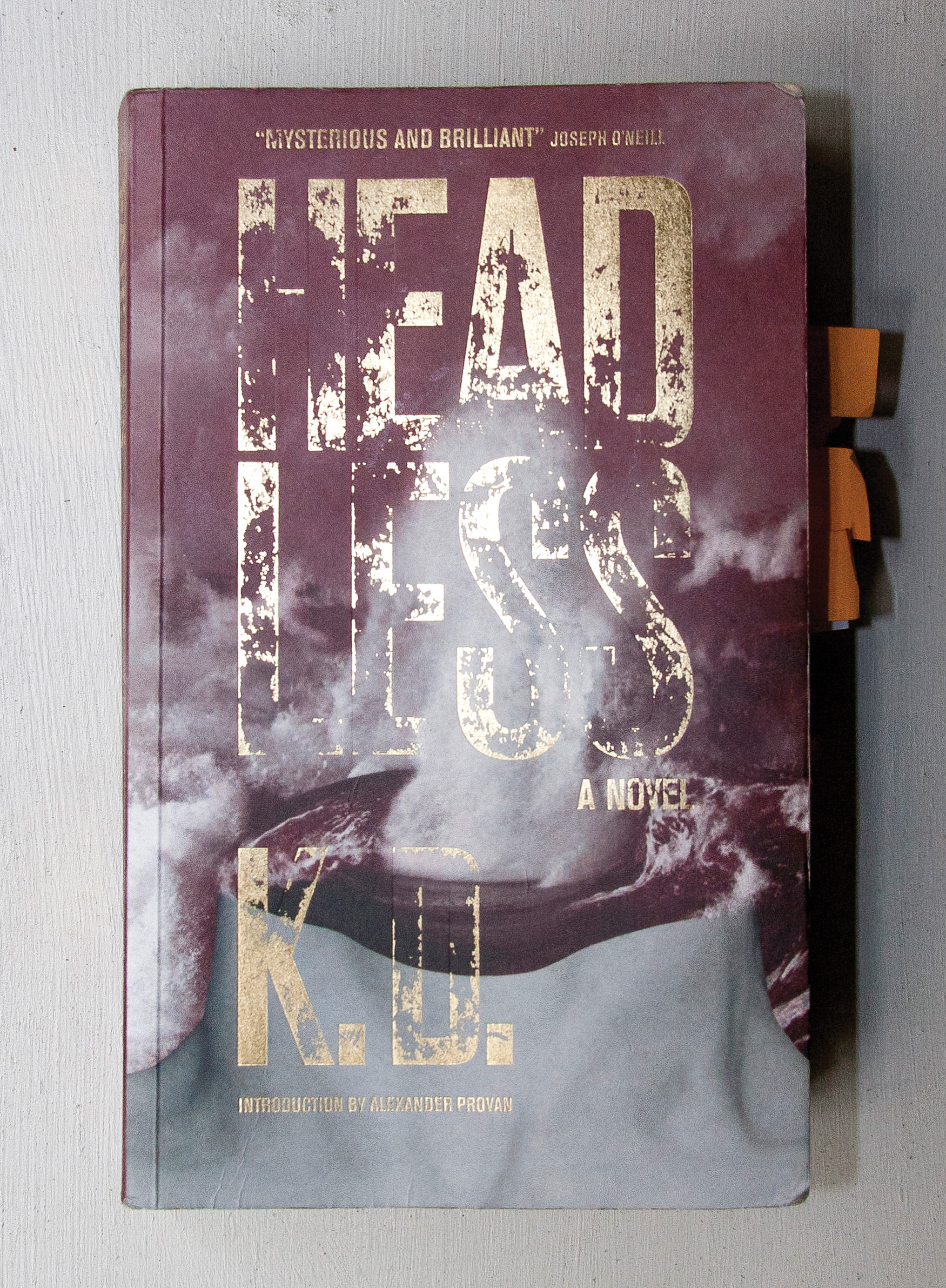
A well-thumbed copy of Headless by K. D. (Berlin: Sternberg Press, 2014). Photo: Travis Diehl.
“In the case of the ongoing Headless project,” they write, “our artistic proposal is not the texts, sceneries, objects, images, videos, or live events produced, but the outsourced structuring of this production. G+S’s practice thereby attempts to locate itself at the same level of abstraction and displacement as the corporate strategies we are investigating.”4 G+S’s casual self-reflexivity and endless prodding result in not a proof of any thesis but a deferral— a mobility wherein one (or one’s money) can disappear. Likewise, beyond fingering Sovereign Trust, the project’s accusations fall short of penetrating the veil of offshore; global finance remains an abstract antagonist.
Armed with a cache of emails between Barlow and G+S, editor Alexander Provan (one of Headless’s eventual publishers) seems both intrigued and confounded by the project that lands somewhat mysteriously in his inbox. The appeal, writes Provan in his vertiginous, fiction-dosed intro to the book, is its apparent lack of didactic political chest-thumping— a stance that, amid the 2008 global financial crash, at once seems to position G+S as prophets and elicits the optimism of the art world.5 Provan quotes a passage from a 2011 Artforum column:
One might conclude that Goldin+Senneby’s project demonstrates that economic fictions can’t be exposed in reality today—in contrast with, for instance, Hans Haacke’s ambitions to catalogue Harry Shapolsky’s Manhattan real estate holdings in the 1970s— because financial reality has become the very site of fiction; hence Goldin+Senneby’s recourse to creative mimicry. But this need not entail accepting the hermetic core of multinational capitalism. More in the Bataillean spirit, one might see in Headless the potential for a collective imagination that would reinvent a politics of regulatory justice (drawing out Bataille’s Marxist roots)…6

Frontispiece of Thomas Hobbes’s Leviathan (detail), designed by Abraham Bosse, 1651.
Though conceived as an airport paperback in the spirit of The Da Vinci Code, much of G+S’s financial scenario plays out in a contemporary art context; mass-market publishers turned down the project. Provan, a founding editor of Triple Canopy, proved a more plausible recruit. “Headless did seem, on the surface, to have it all,” he writes, “but the [literary] agents believed that the Headless conceptual art project still dwarfed the Headless novel.”7 After a couple of years of correspondence with G+S, via Barlow, Triple Canopy joined with Sternberg Press and Tensta Konsthall to print Headless. Its cover is meant to evoke the garish jackets of popular fiction—gold block letters, the author’s name prominently placed—except this book is somehow too nice. The gold text is delicately foil-stamped; the background’s burgundy is a bit too rich; its surrealist severed neck erupting with ocean spray is practically studied.8 Headless ships complete with back-cover blurbs from representatives of the three disciplines the project claims: a fiction writer; a financial expert; and a contemporary artist, whose quote begins, “K. D. has created a masterwork.”
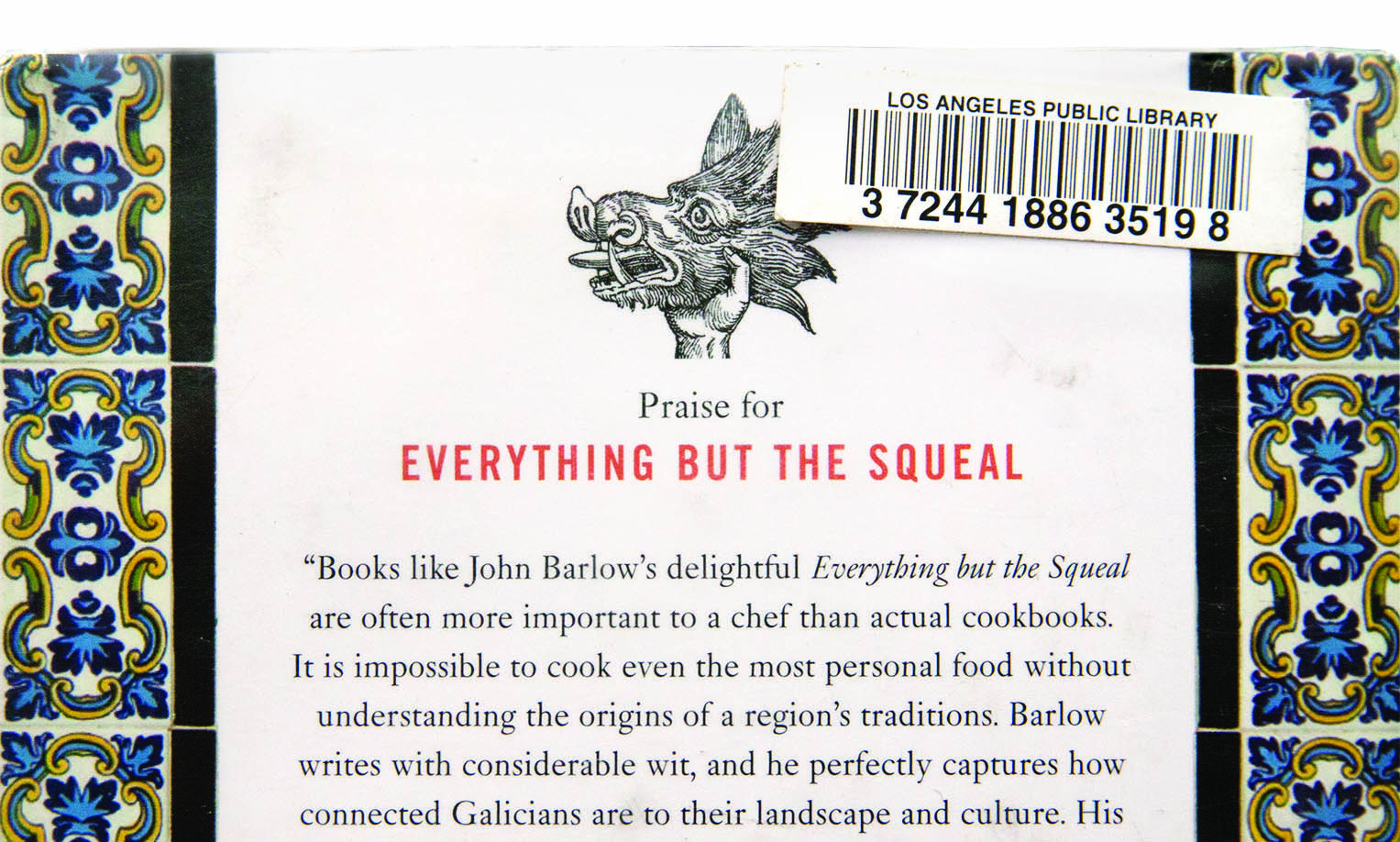
Back cover of John Barlow’s Everything But the Squeal (New York: Farrar Straus and Giroux, 2008) (detail). Photo: Travis Diehl.
Luckily, there’s no need to dissect Headless as literature, nor as the pulp novel it purports to aspire to be; on these counts, one of Barlow’s characters is already an astute judge. Catherine Banks is a secret operative who tries to scare (the fictionalized) Barlow off Acéphale’s trail.9 She is also a dilettante (unpublished) mystery novelist—the inverse of Barlow, who is a mystery writer in real life and a detective in the book.10
She loathes Barlow’s stodgy prose, although she does recognize that at least he’s trying to be commercial. The Detective Novel? Now, that was different.
She began writing it one summer vacation… Over the following year she wrote a novel which, in Cervantes-Joyce-Conan-Doyle-Barthes-Pynchon-Keenean style, she had been sure would blow the lid off crime fiction forever. The result was a cross between Finnegan’s Wake and the quest theme of Don Quixote run backwards through a Pynchonesque distorting chamber that shredded reality three ways: subjectively, objectively, and dystopically-cataclysmically.11
In his potboiler description of the artful manuscript written, contortedly, by one of his own characters, the middling novelist resorts to monstrous hyphenated references, mixed metaphors, and clichés like “blow the lid off.” Barlow acknowledges the modest commercial ambitions of his latest project, while winkingly indulging in name dropping a few heavies. (According to his bio, Barlow studied English at Cambridge and holds a PhD in applied linguistics.) His bluster is punctured with trap doors: Carolyn Keene, for example, is the pseudonym used by the dozens of ghostwriters behind the Nancy Drew mysteries—many of them hacks of the sort Barlow looks down on but that, thanks to G+S, he finds himself aping.
Barlow’s postmodern laterals, however—author in author and book in book—recall not so much Doyle as Cervantes—and less Cervantes’s Don Quixote than the protagonist of novelist Paul Auster’s New York Trilogy, Daniel Quinn.12 City of Glass, the first novella of Auster’s trilogy, is in many ways an actual The Detective Novel—albeit one closer to the pulpy, francophone spirit of Maigret or Poe than to Pynchon. While Barlow must stretch his narrative to encompass each of G+S’s requests, Auster bends every plotline against itself; every lead dries up. In one striking scene, the man Quinn is hired to tail appears at a crowded train station in two versions: one shabby, one well-dressed; from this point on, each fork in the plot is irrevocable and senseless. “But there is no case,” the writer Paul Auster, a character in Auster’s fiction, tells Quinn. “It’s all over.”13
The essential difference between Barlow and Auster—between Barlow and Quinn—between Headless and The Detective Novel—is that the latter intends to collapse the genre, while the former is obligated to produce a paradigmatic example, despite the incompatibility of resolved plots and real-world events. If Manhattan, the setting of Auster’s novella, presents a mazelike, meandering yet contained psychological density, Barlow’s tale takes place in a more spacious yet in some ways more obvious jet-set geography of secrecy: that of offshore finance, places like the Bahamas, Gibraltar, Switzerland. Offshore companies, in the end, are publicly registered, if in an opaque, coded way—not hidden, exactly, but private, secrets in plain sight. The expectation in Headless (both the novel and the project overall) is that even if the trail is difficult to follow, or goes cold, or splits into a quasi-legal tangle of hydra-headed mergers, shell companies, stock transfers, bank accounts, and jurisdictions, the convoluted path of offshore can be traced back to, or at least at one point emitted from, a single, factual source.
Yet G+S’s goal is not to unravel a mystery, but to make one. Barlow may be the writer, but G+S are the authors; they pull Barlow’s strings, adding complications and prompts, suggesting new avenues of inquiry. Clearly they too have no idea where the project will lead. But this only serves an art piece comprised of continuous research—various presentations of an ongoing, indeed endless investigation. Barlow’s novel, following its real-world meta-theatrical subjects, is unfinished throughout the novel’s writing—even after its publication, since Sternberg Press does not quite cut it as the “commercial fiction” stocking airport bookstores envisioned at the project’s outset. Nor does this novel signal the conclusion of the larger project, of which it is simply the most recent installment. Yet Headless is also an end in itself. The famous thriller author Arthur Hailey, who lived much of his life in Nassau as a tax exile, once remarked he wrote books just to see his name on the spine.14 That it’s not G+S or Barlow but the fictionalized K. D.’s name on the spine of Headless is simply another deferral.
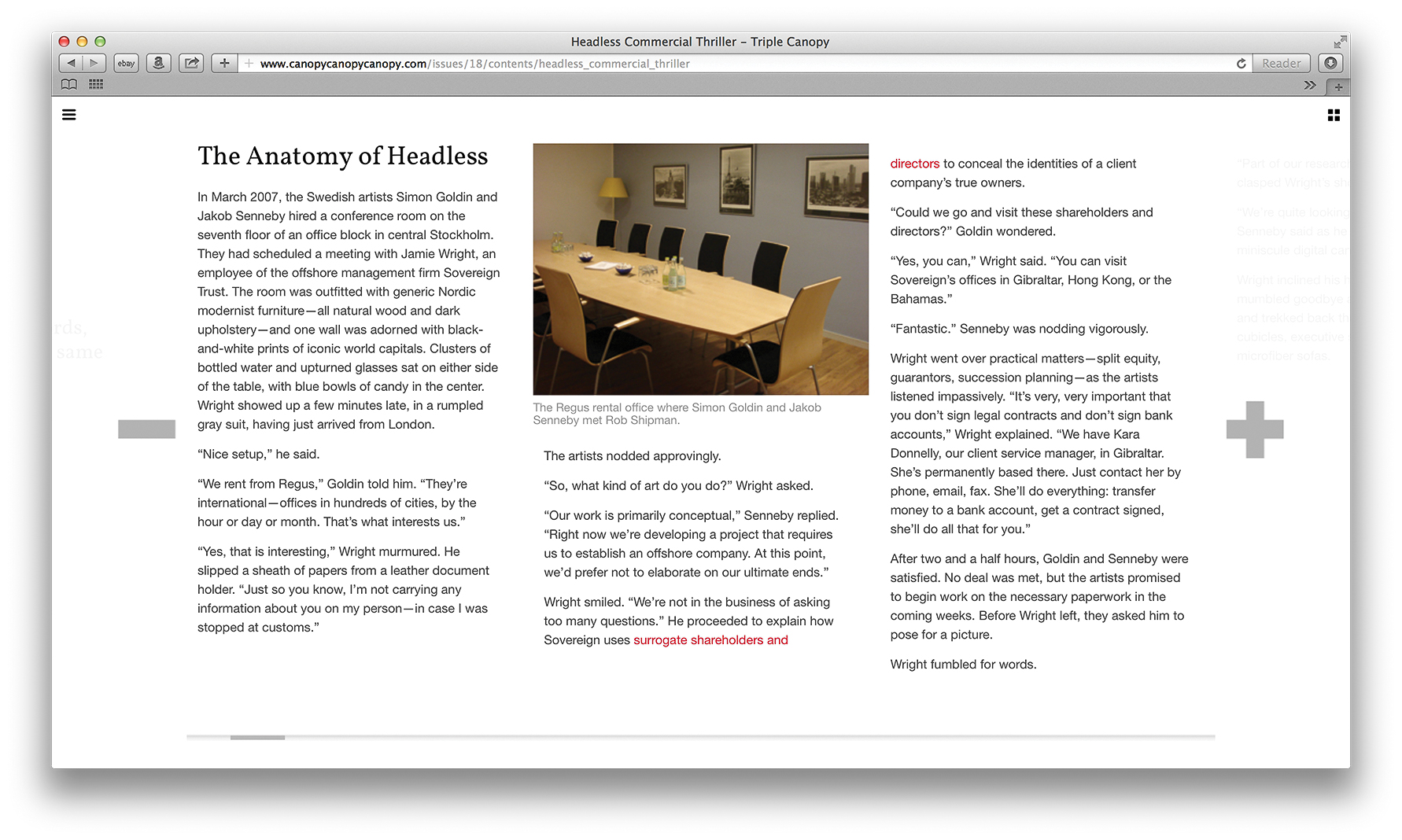
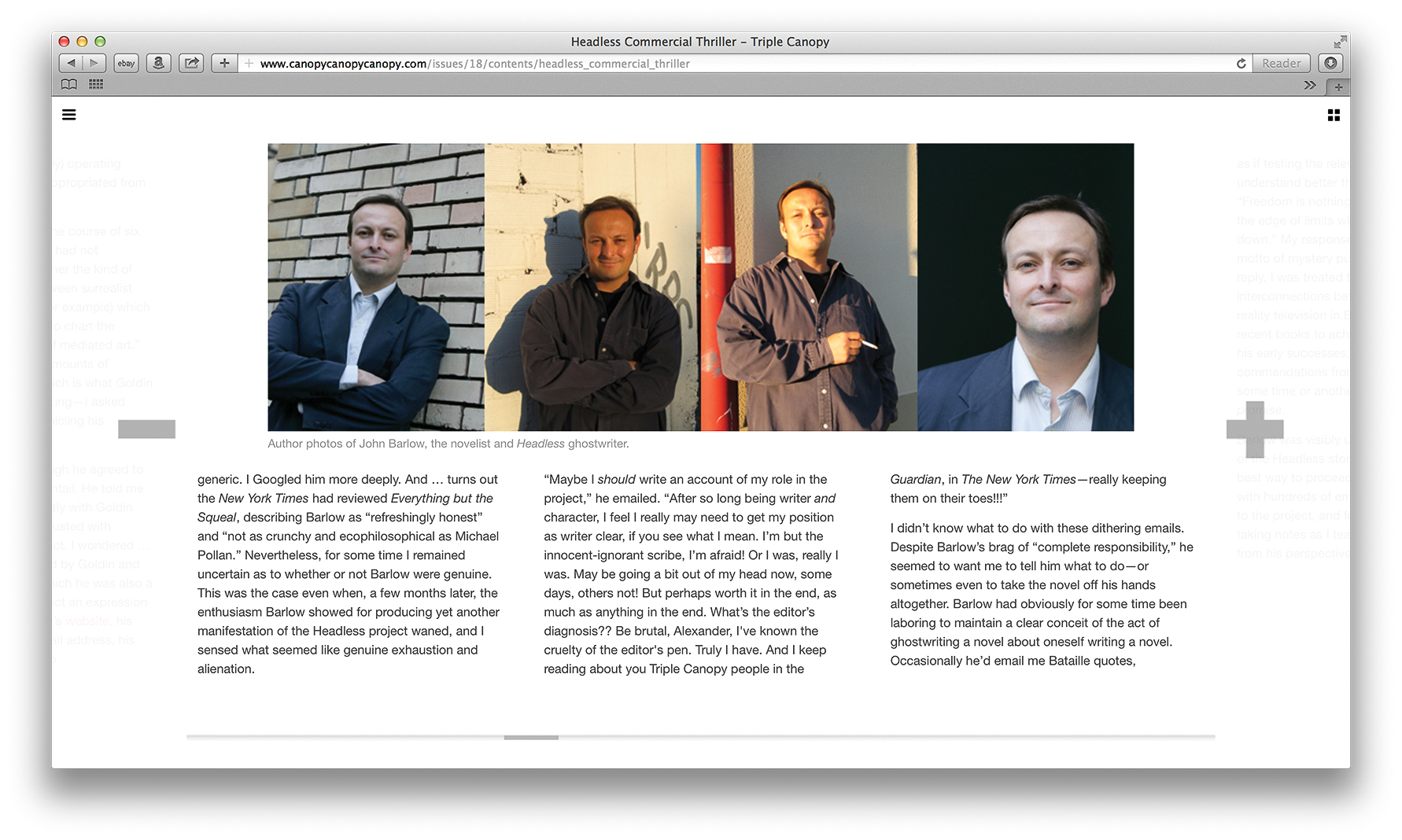
Alexander Provan, “Headless Commercial Thriller,” Triple Canopy 18, 2013. Screenshot courtesy Alexander Provan and Triple Canopy.
Describing Headless, G+S’s artspeak, at once obscurantist and precise, privileges curiosity over conclusions. At one point in Provan’s introduction is a scene where the real-world Barlow, seemingly at a loss, appears to read from an email from the artists:
We are concerned with the strategies of withdrawal and invisibility that are used to construct the legal virtuality of offshore locations. This is where a secret society such as Acéphale might be relevant, in that a secret society is itself an invented, fictional space, as I’m sure you realize. Which explains our interest in the mystery genre.15
Given the vague, exploratory tenor of G+S’s thesis, it’s remarkable how thoroughly their project prompts the wild enthusiasm of their variously complicit and aware collaborators: Alexander Provan, John Barlow, intellectual property lawyer Pia Sarma, and economist Angus Cameron, among others.16 Barlow, for example, never delves too deep into a question that, by the stage of the novel’s publication, is perhaps too late to ask: Why him? Cameron, a political economist with a bachelor’s degree in art history, became G+S’s official spokesperson, thereafter providing lengthy elaborations on offshore, xenomoney, and abstract geography in scattered academic and art-world settings.17 Their gusto mimics the ease with which the protagonists of novels take up their pursuits on faith. “It was a wrong number that started it,” begins City of Glass, “the telephone ringing three times in the dead of night, and the voice on the other end asking for someone he was not.”18 An endnote in a lengthy peer-reviewed paper published by Cameron on Headless is revealing: “The memo was forwarded to Goldin+Senneby, and by them to me. I cannot, therefore, prove its authenticity; but equally I have no reason to doubt it.”19
For their part, G+S enact a fascination with offshore, with finance, with secrecy, without, however, committing to any of it—much in the way that artists both require and disavow the largesse of “faceless” global corporations. G+S are only implicitly critical of any of the spheres Headless intersects, outsourcing not only the project’s acts and their recording, but also its morality. Leave it to Cameron, at a lecture at the Power Plant in Toronto, to use the word “amoral” in reference to offshore tax schemes.20 In a documentary commissioned by the artists from Kate Cooper and Richard John Jones, one author who had infiltrated a tax-law firm describes tax evasion as shirking a social obligation, robbing not a government but its people of deserved spending.21 And who bears responsibility for an anarchic artwork? Like companies that resort to offshore, G+S become the contemporary opposite of noblesse oblige: privileged elites preemptively beheaded, thus unaccountable in every sense.
Cameron makes the most compelling case for the usefulness of their methods, arguing for an understanding of Headless as “paradox”—a sort of productive corollary to ambivalence—which, in the tradition of Renaissance thinkers, allows intellectuals to try on new and controversial ideas without committing to a potentially dangerous stance.22 The project Headless, he suggests, may be as morally neutral as tax laws themselves—setting aside the creative ways they’re used—and so provides an invaluable economic model. Today, moving to understand and perhaps challenge neoliberalism without seeming neoliberal, one risks not life so much as some kind of intellectual cachet. In fact, as Cameron and Provan both notice, it is precisely G+S’s ambiguous (“paradoxical”) stance that resists easy digestion as either didactic or complicit.
But what if the model, like its object, is predicated on a morally and artistically questionable stance? In the first of their only two conversations, Auster’s Quinn discusses Cervantes with the character Paul Auster—a nested literary exchange that is the most explicit meditation on fact and fiction in City of Glass:
“But you still haven’t explained why a man like Don Quixote would disrupt his tranquil life to engage in such an elaborate hoax.”
“That’s the most interesting part of all. In my opinion, Don Quixote was conducting an experiment. He wanted to test the gullibility of his fellow men. Would it be possible, he wondered, to stand up before the world and with the utmost conviction spew out lies and nonsense?”23
Lies and nonsense might help a company avoid taxes. They might also make for engaging art. But in managing their project through the lives of others, the artists’ fiction crosses into reality. In one egregious case, G+S hire a Spanish detective to follow the real-world K. D. in Gibraltar, where she works for Sovereign Trust. A fabrication? A nod to Sophie Calle? A capricious invasion of privacy? Or something more threatening, more judgmental? (And what about the real-world Barlow—did his marriage really disintegrate, as it does in the book? Would it change the reading if it had?)
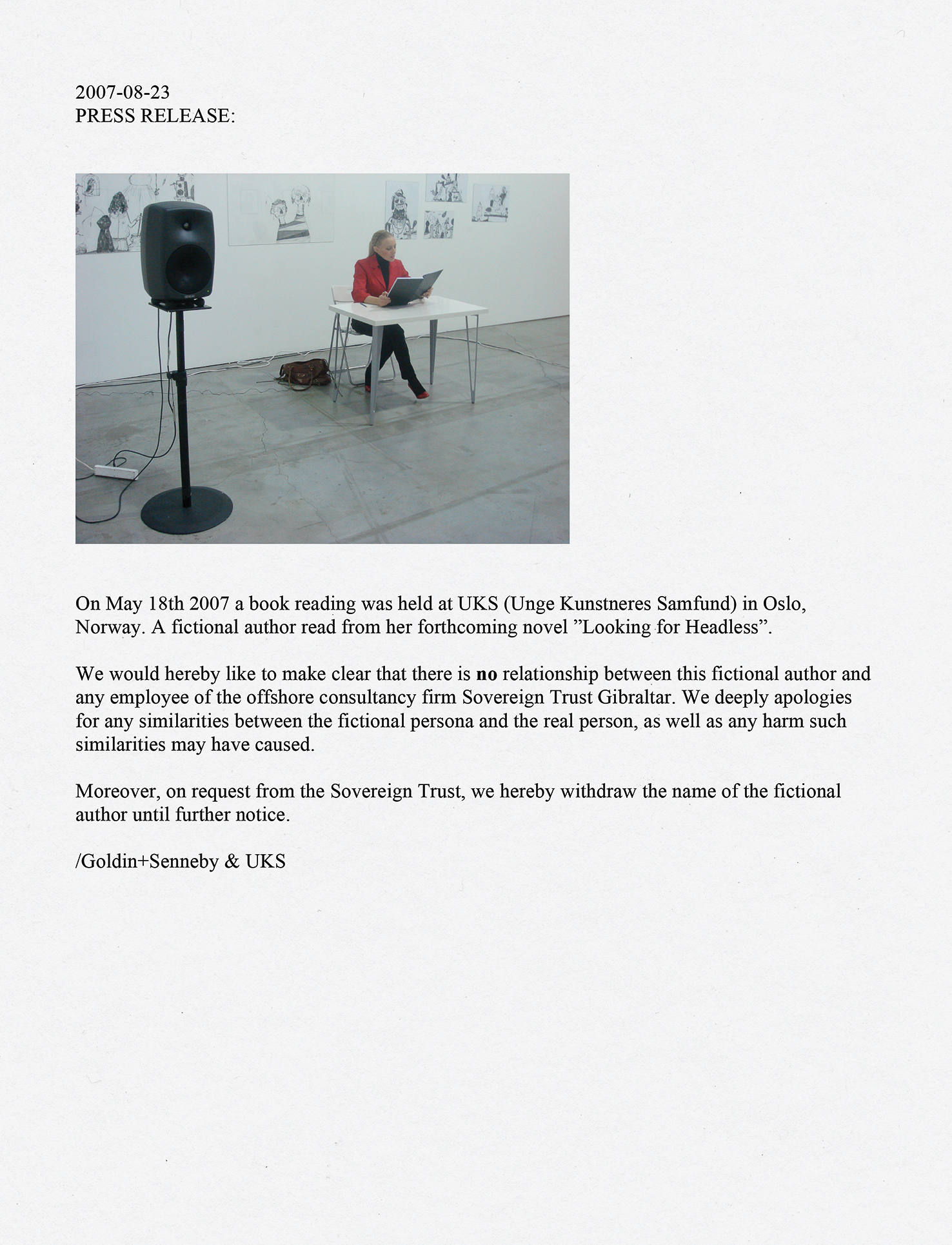
Goldin+Senneby, Untitled press release, August 2007. Image courtesy Goldin+Senneby.
A need plainly exists among artists and their parafunctionaries to apprehend, and possibly even engage, a grave socioeconomic prospectus. The question is to what degree one can, and should, do so from an unambiguously progressive stance. On one side are Jeff Koons and Santiago Sierra, who—despite the polarity of their neoliberal and antiglobalization politics, respectively—reenact exploitative structures to the letter. On the other, the work of artists like Allan Sekula and Martha Rosler features a clear liberal (anti-war, pro-worker) agenda.24 Another example is comedian Stephen Colbert’s exposé of American campaign finance, during which he successfully founded his own Super-PAC, a proxy through which candidates might receive unlimited contributions from anonymous donors.25 If Goldin+Senneby ultimately find the private world of offshore finance impossible to penetrate, and much easier (if morally ambiguous) to imitate, the Headless project might yet galvanize an art audience searching for appropriate metaphors for a world of increasing inequality.
For Sternberg Press, a publishing house specializing in critical artistic texts since 1999, G+S’s Headless joins a catalog that includes the anthologies Are You Working Too much?: Post-Fordism, Precarity, and the Labor of Art; Art Production beyond the Art Market?; Contemporary Art and Its Commercial Markets: A Report on Current Conditions and Future Scenarios; and Corporate Mentality; as well as the title Sex, Art, and the Dow Jones.26 If previous generations of artists have conveniently ignored or actively scorned the market, those of the past decade appear prepared if not to bite the invisible hand that feeds them then at least to give its owner a good long look. In 2008, in a moment embellished with masonic significance in Headless, G+S are shortlisted for an art prize given by Sovereign Trust.27 Infiltrating a field of figurative painters and photographers, the pair exhibits an etching (Nassau, 6 a.m.) related to the novel’s Bataillian imagery: a headless man running on a beach, as if stylishly retired in an equatorial tax haven. A company like Sovereign—or like Hugo Boss, Absolut Vodka, or UBS—might sponsor an art prize to shed taxable income, while gaining a bonus of cultural capital. The presence of G+S and Headless on this occasion insinuates, by association, the whole of art finance in shady dealings. Not only because it rings true does this scene have the dullness of the art-world du jour. Confronting areas that are outside of their expertise, like offshore finance, artists like G+S and their collaborators risk getting worked up about abstract maneuvers that are, to others, entirely prosaic.
The Headless novel is not a sophisticated work of literature. Barlow’s effort proves less interesting than what it touches. Still, its fateful inconclusiveness, beholden to its inelegantly imperfect narrative arc, ends up performing exactly the mangled version of the mystery genre requested by G+S. Nor would a tour de force by Barlow have suited the purpose of a larger project with, indeed, no head in sight. Questions remain unanswered; the ledger of fact, fictionalization, and dissimulation lies unreconciled. Nevertheless, while the narrator of Paul Auster’s City of Glass shuns the fictional author Paul Auster, he is unable to forget Quinn, the hack writer turned disappeared detective:
As for Auster, I am convinced that he behaved badly throughout. If our friendship has ended, he has only himself to blame. As for me, my thoughts remain with Quinn. He will be with me always. And wherever he may have disappeared to, I wish him luck.28
Such is the power of good fiction.
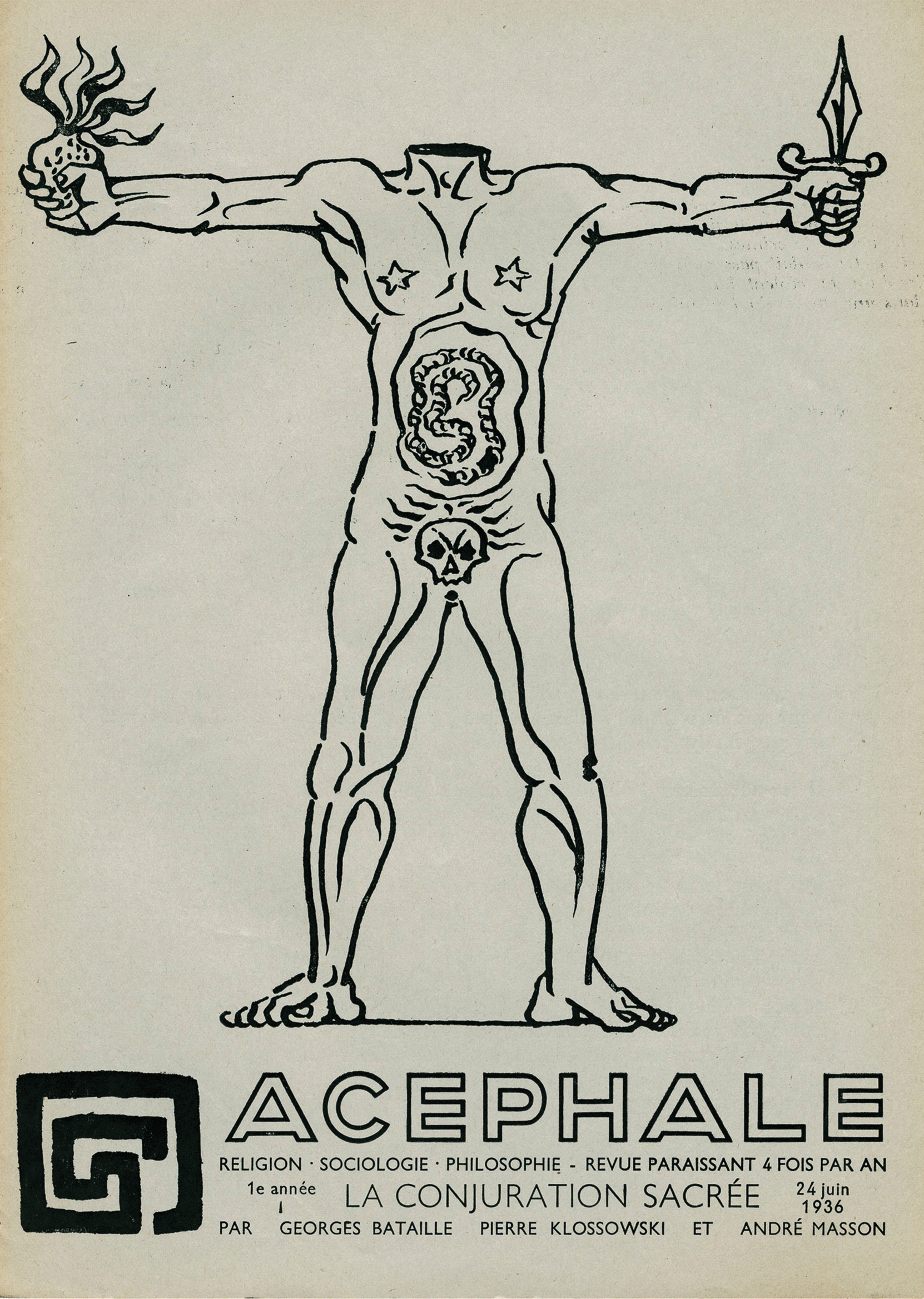
Front cover of Acéphale, designed by André Masson, 1936.
Bataille, philosopher and novelist, founded the society of Acéphale in the 1930s. Little is known about their activities outside five issues of an eponymous periodical. Under the gathering clouds of World War II (they were unable to publish the fifth before war broke out), Bataille’s and others’ writing argues against Hitler’s appropriation of Nietzsche: If rationalism and the übermensch could be twisted into genocidal fascism, then best to amputate the seat of reason: the head. Accordingly, Acéphale’s cover, designed by André Masson, features the emblem of a decapitated Vitruvian Man, in his outstretched hands a flaming heart and a sword, a skull over his groin in an embrace of deathly ecstasy. Bataille’s group planned a secret ritual to sacrifice one of their own. They found willing victims (by some accounts Bataille himself volunteered)—but none who would wield the knife. Acéphale decapitated a monkey instead. In fiction, though, you can kill as many people as you want. And what if, like Bataille and his cohort, like Barlow and G+S, one finds oneself unwilling to cross the last line?
Travis Diehl lives in Los Angeles. His video work has been shown at Curtat Tunnel, Lausanne; Anthony Greaney, Boston; Human Resources, Los Angeles; and the Centre Pompidou, Paris. His writing appears in Night Papers, East of Borneo, Even, X-TRA, Salon, and Artforum. He is a 2013 recipient of the Creative Capital | Warhol Foundation Arts Writers Grant. He edits the artist-run arts journal Prism of Reality.
